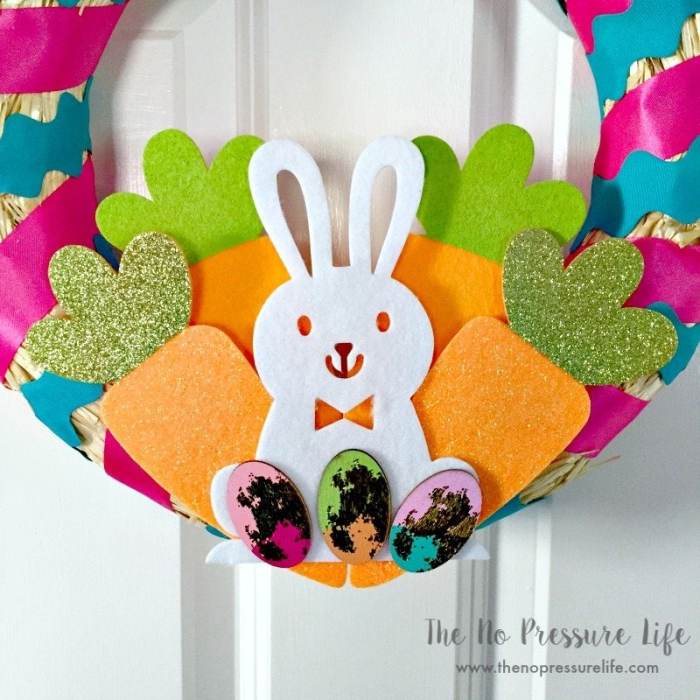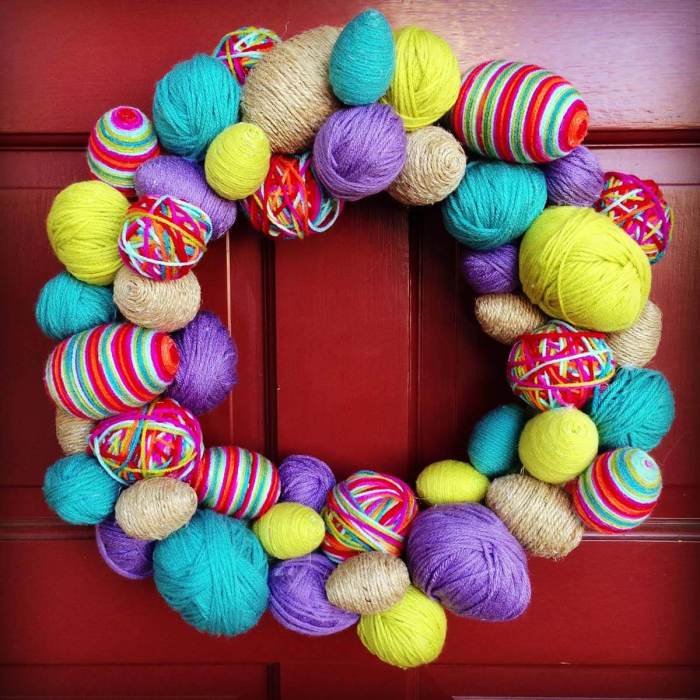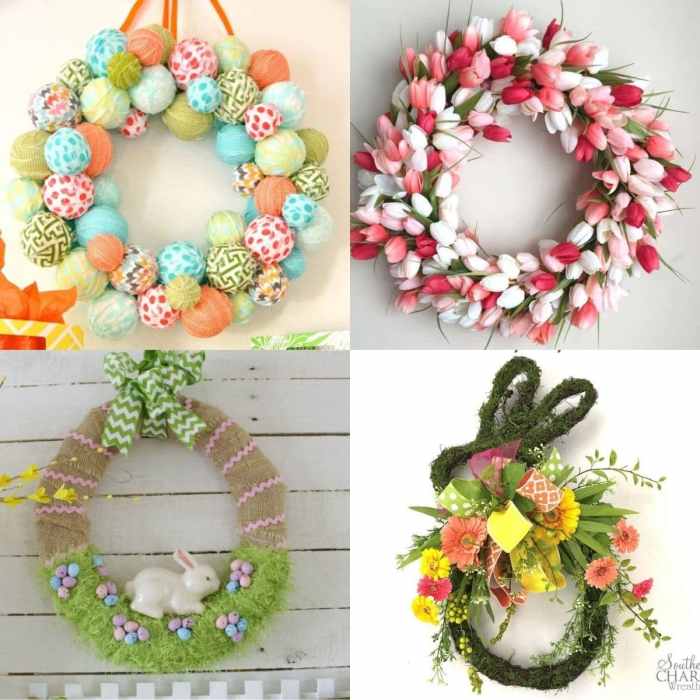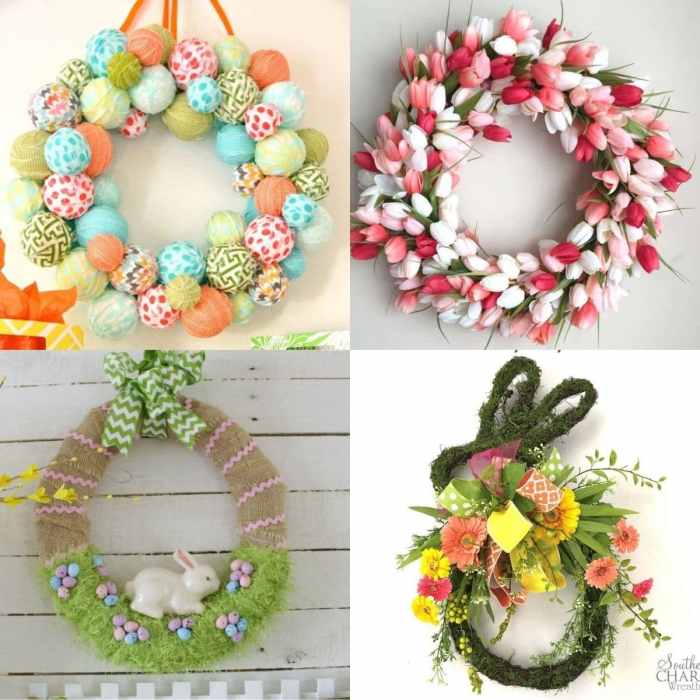Easter Wreath DIY: Spring is in the air, and what better way to celebrate the arrival of new life than with a beautiful Easter wreath? These cheerful decorations are a delightful way to welcome the holiday, and with a little creativity, you can create a unique and personalized wreath that reflects your own style.
From traditional designs to modern interpretations, the possibilities for Easter wreaths are endless. This guide will take you through the process of crafting your own Easter wreath, from choosing the right materials to adding festive touches. Whether you’re a seasoned crafter or a beginner, you’ll find everything you need to create a stunning Easter wreath that will impress your guests and brighten your home.
Essential Materials for DIY Easter Wreaths

Creating a DIY Easter wreath is a fun and rewarding project. You can personalize it with your favorite colors, themes, and embellishments. To get started, gather the necessary materials. You can find most of these items at your local craft store or online.
Wreath Base
The base of your Easter wreath will determine its overall size and shape. You have several options to choose from:
- Wire wreath form: These are inexpensive and readily available in various sizes. They are versatile and can be easily shaped and decorated.
- Grapevine wreath: These add a natural and rustic touch to your wreath. They come in different sizes and can be found at craft stores or garden centers.
- Foam wreath ring: These are lightweight and easy to work with. They provide a sturdy base for heavier decorations and are ideal for beginners.
- Styrofoam wreath ring: These are lightweight and inexpensive. They are a good option for creating wreaths with a smooth and even surface.
Decorations
This is where you can unleash your creativity and personalize your Easter wreath. Some popular options include:
- Easter eggs: These can be real eggs, plastic eggs, or even blown eggs. You can decorate them with paint, glitter, or markers.
- Flowers: Fresh flowers, silk flowers, or paper flowers are all great options for adding color and texture to your wreath.
- Ribbons: Choose ribbons in various colors and patterns to create bows, streamers, or accents.
- Bunny ears: These can be made from felt, paper, or fabric and add a playful touch to your wreath.
- Other Easter-themed decorations: Consider adding items like chicks, bunnies, carrots, and spring-themed embellishments.
Tools
You will need a few basic tools to assemble your Easter wreath:
- Hot glue gun: This is essential for attaching decorations to the wreath base.
- Scissors: Use these to cut ribbons, paper, and other materials.
- Wire cutters: These are helpful for shaping wire wreath forms or securing decorations.
- Floral wire: This can be used to create loops for hanging your wreath or to secure delicate decorations.
Choosing the Right Wreath Base
The foundation of your Easter wreath is the base, and choosing the right one is essential for a successful project. Different types of wreath bases offer unique advantages and disadvantages, so it’s crucial to consider your desired style, materials, and overall vision for the wreath.
Types of Wreath Bases
The type of wreath base you choose will influence the overall look and feel of your Easter wreath. Here’s a breakdown of popular options:
- Foam Wreath Bases: Foam wreath bases are lightweight, versatile, and easy to work with. They come in various sizes and shapes, making them suitable for both small and large wreaths. The foam material allows you to easily insert floral stems, ribbons, and other decorations. However, foam bases can be fragile and may not hold heavy items securely. They are also not water-resistant, so they may require additional protection if used outdoors.
- Wire Wreath Bases: Wire wreath bases are sturdy and durable, making them ideal for creating large and elaborate wreaths. They are also water-resistant, making them suitable for outdoor use. However, wire bases can be more challenging to work with than foam bases, as they require more force to insert decorations. They are also less versatile in terms of shape and size.
- Natural Wreath Bases: Natural wreath bases, such as grapevine, willow, or straw, offer a rustic and organic aesthetic. They are also environmentally friendly and biodegradable. However, natural bases can be more expensive and may require additional preparation, such as soaking or drying, before use. They are also less durable than foam or wire bases and may not hold heavy items securely.
Choosing the Right Size and Shape
The size and shape of your wreath base will depend on your desired aesthetic and the amount of decorations you plan to use. For a smaller wreath, a 10-inch base is sufficient. For a larger wreath, consider a 12-inch or 14-inch base. If you plan to use a lot of decorations, you may need a larger base to accommodate them.
Consider the shape of the base as well. Round bases are the most common, but you can also find oval, square, or heart-shaped bases. The shape of the base can add a unique touch to your wreath.
Step-by-Step Guide to Making an Easter Wreath: Easter Wreath Diy
This section will guide you through the process of creating your Easter wreath step-by-step. With clear instructions and visual aids, you’ll be able to craft a beautiful and festive wreath that will bring joy to your home.
Preparing the Wreath Base
Before you begin decorating, you need to prepare your wreath base. This involves ensuring it’s clean and ready to accept your embellishments.
- Clean the Base: If your wreath base is new, simply wipe it down with a damp cloth to remove any dust or debris. If you’re using a pre-owned wreath base, give it a thorough cleaning with soap and water. Ensure it’s completely dry before proceeding.
- Add a Layer of Texture: For a more interesting and visually appealing wreath, consider adding a layer of texture to your base. You can use burlap ribbon, raffia, or even a layer of moss to create a foundation for your decorations.
Attaching the Decorations
Now that your wreath base is ready, it’s time to add your Easter decorations. This step allows you to unleash your creativity and personalize your wreath.
- Start with a Focal Point: Choose a central element for your wreath, such as a large Easter egg, a bow, or a floral arrangement. This will serve as the anchor for your design.
- Layer the Decorations: Once you’ve placed your focal point, start layering your decorations around it. You can use a variety of elements like faux flowers, ribbons, and other Easter-themed ornaments. Experiment with different textures and colors to create a visually appealing composition.
- Use Wire or Glue: To secure your decorations, you can use floral wire or hot glue. Floral wire is ideal for attaching lightweight items, while hot glue is better for heavier or more delicate elements.
Adding the Finishing Touches
The finishing touches are what will truly make your Easter wreath stand out. This step involves adding the final details that will complete your design.
- Incorporate Easter Eggs: Easter eggs are a must-have for any Easter wreath. You can use real eggs that have been dyed or decorated, or you can opt for faux eggs.
- Add a Touch of Green: Incorporating greenery like faux ferns or eucalyptus sprigs can add a natural touch to your wreath and complement your Easter decorations.
- Hang Your Wreath: Once you’re satisfied with your design, hang your wreath in a prominent spot in your home. You can use a ribbon or a hook to hang it.
Tips and Tricks
Here are a few tips and tricks to help you create a professional-looking Easter wreath:
- Use a Variety of Textures and Colors: Combining different textures and colors will add depth and visual interest to your wreath.
- Don’t Overcrowd: Too many decorations can make your wreath look cluttered. Leave some space between elements to allow for breathing room.
- Balance the Design: Aim for a balanced design by distributing the decorations evenly around the wreath.
- Use a Wire Cutter: When working with floral wire, use a wire cutter to trim the wire to the desired length. This will help you create a clean and professional finish.
- Practice Makes Perfect: Don’t be afraid to experiment and practice. The more you create, the better you’ll become at making Easter wreaths.
Adding Festive Touches
Now that your Easter wreath base is ready, it’s time to add some festive touches to make it truly eye-catching. Think of it as a blank canvas just waiting for your creative flair.
This section explores ways to add ribbons, bows, and embellishments, as well as incorporate natural elements like flowers, branches, and eggs. You’ll also find ideas for unique and eye-catching accents.
Incorporating Ribbons and Bows
Ribbons and bows add a touch of elegance and color to any Easter wreath. Choose ribbons in springy hues like pastel pink, yellow, blue, and green. You can also use a combination of colors for a more vibrant look.
- Tie ribbons around the wreath base: Use a simple knot or a more elaborate bow.
- Create a cascading effect: Attach ribbons of different lengths to the wreath base for a flowing look.
- Layer ribbons for added texture: Use ribbons of varying widths and textures for a more dimensional look.
Adding Embellishments
Embellishments add personality and whimsy to your Easter wreath. Consider these ideas:
- Easter-themed charms: Add charms shaped like bunnies, chicks, eggs, or flowers.
- Fabric scraps: Cut out fabric shapes like butterflies, flowers, or hearts and attach them to the wreath.
- Buttons: Use a variety of buttons in different colors and sizes to create a unique pattern.
- Sequins: Add a touch of sparkle with sequins in pastel shades.
Incorporating Natural Elements
Natural elements bring a touch of nature and freshness to your Easter wreath.
- Flowers: Fresh or silk flowers in pastel shades like pink, yellow, and lavender will add a touch of beauty.
- Branches: Use branches of willow, pussy willow, or forsythia to create a natural frame for your wreath.
- Eggs: Decorate real or artificial eggs with paint, glitter, or markers and attach them to the wreath.
Creating Unique Accents
- Painted eggs: Paint eggs in bright colors and patterns, then attach them to the wreath with ribbon or wire.
- Bird nests: Add a small bird nest filled with colorful eggs or faux feathers for a rustic touch.
- Bunny ears: Create bunny ears from felt or fabric and attach them to the wreath for a whimsical touch.
- Wooden signs: Add a personalized touch with a wooden sign featuring an Easter message or greeting.
Easter Wreath Inspiration Gallery

Looking for some creative inspiration to craft your own Easter wreath? You’ve come to the right place! We’ve gathered a collection of stunning Easter wreath designs that will spark your imagination and help you create a truly unique and festive piece for your home.
Examples of Easter Wreath Designs
This gallery showcases various Easter wreath designs, each with its unique charm and appeal.
- Rustic Chic: A simple yet elegant wreath featuring a natural grapevine base adorned with burlap ribbon, faux eggs in muted tones, and a touch of greenery. This design exudes a relaxed and cozy vibe, perfect for a farmhouse or country-style home.
- Springtime Bloom: This vibrant wreath bursts with colorful blooms, featuring a mix of pastel pink, yellow, and purple silk flowers. A touch of faux greenery adds a natural element, while a few decorative eggs complete the festive look. This design is perfect for adding a splash of color to any entryway or front door.
- Modern Minimalist: For a sleek and contemporary aesthetic, opt for a minimalist wreath with a simple wire base. Adorn it with a few faux eggs in metallic finishes, such as gold or silver, and add a touch of greenery for a modern twist. This design is perfect for a minimalist or Scandinavian-inspired home.
- Bunny Charm: This whimsical wreath features adorable bunny figurines, adding a playful touch to your Easter decor. Combine bunnies with pastel-colored eggs, ribbons, and a touch of greenery for a truly delightful creation. This design is perfect for adding a touch of whimsy to a child’s room or play area.
Easter Wreath Care and Maintenance

Your Easter wreath is a beautiful centerpiece, but like any decorative element, it needs some care and attention to maintain its freshness and beauty. This section will provide tips on how to keep your wreath looking its best throughout the Easter season and beyond.
Preserving the Longevity of Your Easter Wreath
Maintaining the vibrancy and longevity of your Easter wreath requires a few simple steps. These practices will help preserve the beauty of your wreath and ensure it stays in good condition for the Easter season and potentially beyond.
- Choose the Right Materials: Opt for materials that are naturally durable or have been treated to withstand the elements. For example, silk flowers, faux greenery, and weather-resistant ribbons are good choices for an outdoor wreath. Avoid delicate materials that may easily fade or become damaged.
- Protect from Direct Sunlight: Prolonged exposure to direct sunlight can cause colors to fade and materials to deteriorate. Place your wreath in a location that receives filtered sunlight or partial shade. Consider moving it indoors during the hottest parts of the day.
- Avoid Moisture: Moisture can lead to mold growth and damage, especially for natural materials. Avoid placing your wreath in areas where it may be exposed to rain or excessive humidity. If you’re using a wreath outdoors, choose a location that has good drainage and shelter from the elements.
- Regularly Dust: Dust can accumulate on your wreath, making it look dull. Use a soft brush or a vacuum cleaner with a brush attachment to gently remove dust and debris. Avoid using water or harsh chemicals that could damage the materials.
Easter Wreath Gift Ideas
Gifting a homemade Easter wreath is a thoughtful and personalized way to show your loved ones you care. It’s a beautiful and festive gesture that will brighten their homes and celebrate the spirit of spring.
The beauty of crafting a DIY Easter wreath lies in its versatility. You can tailor it to the recipient’s preferences and style, making it a truly unique and meaningful gift.
Creative Packaging and Presentation Ideas
A well-presented gift enhances its value and adds a touch of elegance. Here are some creative ideas for packaging your Easter wreath:
- Gift Basket: Place the wreath in a woven basket lined with colorful tissue paper. Add Easter-themed treats, such as chocolate bunnies, candy eggs, or a small potted plant, to create a delightful surprise.
- Gift Box: Select a sturdy box slightly larger than the wreath. Line it with decorative paper and wrap the wreath in tissue paper. Secure it with a ribbon or twine, and add a personalized gift tag.
- Fabric Wrap: Wrap the wreath in a festive fabric, such as burlap, linen, or patterned cotton. Tie it with a ribbon or twine, and add a small Easter-themed embellishment, such as a ribbon bow or a miniature bunny.
Personalized Touches for Unique Gifts
Personalizing your Easter wreath adds a special touch that makes it truly unique and memorable. Consider these ideas:
- Monogrammed Ribbon: Add a ribbon with the recipient’s initials or a meaningful message. This adds a personal touch and makes the gift feel extra special.
- Personalized Charm: Include a small charm with a meaningful symbol, such as a heart, a cross, or a bunny. This adds a personal touch and makes the gift feel extra special.
- Family Photo: Attach a small framed family photo to the wreath. This adds a personal touch and makes the gift feel extra special.
Easter Wreath FAQs
Crafting an Easter wreath is a delightful way to celebrate the spring season. It’s a fun project for all skill levels, but you might have a few questions as you embark on your creative journey. This section addresses some of the most common questions about DIY Easter wreaths, offering tips and insights to help you create a beautiful and festive centerpiece.
When is the best time to start making an Easter wreath?
The ideal time to start making an Easter wreath is about a month before the holiday. This gives you ample time to gather materials, experiment with different designs, and ensure everything is ready for display.
What are the best materials for an Easter wreath?, Easter wreath diy
Easter wreaths are typically made from a variety of materials, including:
- Wreath Base: You can choose from a variety of wreath bases, including grapevine, wire, straw, or foam. Grapevine wreaths provide a natural, rustic look, while wire wreaths offer flexibility and durability. Straw wreaths are perfect for a traditional farmhouse style, and foam wreaths provide a smooth surface for attaching decorations.
- Decorations: The most popular Easter wreath decorations include:
- Fresh Flowers: Tulips, daffodils, lilies, and other spring blooms add vibrant color and fragrance.
- Artificial Flowers: Silk or plastic flowers offer a long-lasting alternative to fresh blooms, and they come in a wide variety of colors and styles.
- Ribbons: Add a touch of elegance and festivity with colorful ribbons.
- Easter Eggs: Painted, decorated, or even real eggs can be used to create a whimsical and colorful wreath.
- Bunnies: Wooden, plush, or fabric bunnies are a classic Easter decoration.
- Other Seasonal Elements: Consider incorporating other spring elements such as birds, butterflies, or even small chicks.
How long will an Easter wreath last?
The lifespan of your Easter wreath depends on the materials you use.
- Fresh Flowers: Fresh flowers will typically last for about a week, depending on the type of flowers and how they are cared for.
- Artificial Flowers: Artificial flowers can last for several years if they are properly cared for.
- Other Decorations: Most other decorations, such as ribbons, eggs, and bunnies, can last for several seasons if they are stored properly.
What are some tips for making a beautiful Easter wreath?
Here are some tips to help you create a stunning Easter wreath:
- Plan your design: Before you start assembling your wreath, sketch out a rough design or gather inspiration from online resources. This will help you visualize the final product and ensure that you have all of the necessary materials.
- Use a variety of textures and colors: Incorporate a mix of different textures and colors to add depth and visual interest. For example, you could use a combination of silk flowers, ribbons, and wooden eggs.
- Balance the wreath: Make sure that the decorations are evenly distributed around the wreath. Avoid overcrowding the wreath, and leave some space between the elements.
- Add a personal touch: Personalize your wreath with meaningful items, such as family photos, handwritten messages, or special trinkets.
How do I store an Easter wreath?
After the Easter holiday, store your wreath in a cool, dry place. If you used fresh flowers, discard them and replace them with artificial ones for future use. For artificial flowers, gently brush off any dust or debris and store them in a sealed plastic bag.
What are some alternative Easter wreath ideas?
If you’re looking for a unique twist on the traditional Easter wreath, consider these ideas:
- Miniature wreaths: Create a collection of small wreaths to decorate your table or mantel.
- Wreaths with a specific theme: Choose a theme, such as “pastel colors” or “vintage Easter,” and incorporate decorations that reflect that theme.
- Wreaths with a personal touch: Incorporate items that have special meaning to you, such as family photos or mementos.
With a little effort and imagination, you can create a beautiful and unique Easter wreath that will be the centerpiece of your holiday decor. Not only is it a fun and rewarding project, but it’s also a wonderful way to personalize your home and share the joy of the season with loved ones. So gather your supplies, get creative, and let’s make some Easter magic!
Crafting an Easter wreath is a fun way to welcome spring. You can use fresh greenery, colorful eggs, and even ribbon to create a festive display. If you’re looking for a more practical DIY project, consider a DIY tub to shower conversion to upgrade your bathroom. Once you’ve finished your DIY projects, you can enjoy the beauty of spring and your new shower.

